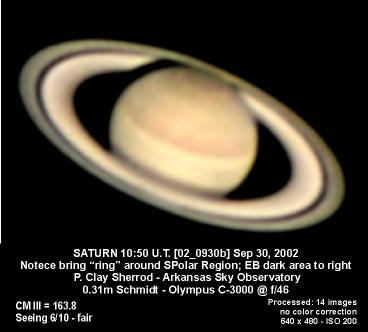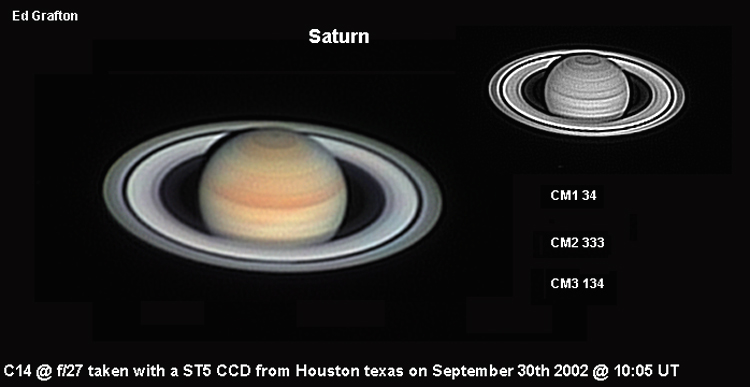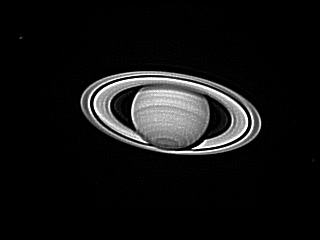土星 月惑星研究会 関西支部 (最新)
ALPO-Japan Latest
Saturn Image 2002/09/30(UT)
Clay Sherrod,Ed Grafton
Clay,E.Grafton
|
Dr. P. Clay Sherrod (310mm Schmidt Olympus C-3000 camera)
|
|

2002/09/30 10:50(UT)
[Dr. P. Clay Sherrod Arkansas State U.S.A]
≪クレイ シェラード アメリカ アーカンサス≫
|
Ed Grafton (14 inch f/11 Celestron SCT, ST5 CCD 5)
|
|

Image data:
L = 69 .25 sec exposures clear filter
R = 15 .60 sec exposures red filter
G = 15 .60 sec exposures green filter
B = 15 .6o sec exposures blue filter
Seeing was good to excellent 8-9/10.
Transparancy was good 7/10, no wind and heavy dew.
Hi Guys
Here is an image taken September 30th 2002 at 10:05 from Houston Texas. The
CM for the spot latitude (CM3) is 134 in this image compared to about 94 for
the 29th image where the spot was on the CM. Therefore the spot is about 40
degrees past the CM in the 9/30 image which should be to the left of the CM
as presented. The 30th image resolution is as good as the 29th image yet the
spot is practically undetectable with just a hint of its presence being
noted most easily in the inset image. The lack of prominace in the 30th
image compared to the 29th is puzzling.
Possible explanations may be that 1) the spot is changing rapidly, 2) the
image resolution on the 30th is not a good as the 29th, although all
indications is that it is, 3) The spot represents a "hole" in the atmosphere
and is more easily seen when near the CM where it is not as obscured by a
higher level haze layer when seen from a more edge on perspective. There is
some support for the last conjecture as on the set of 4 images on the 29th
where the rotation was demonstrated; the spot is much more prominent in the
two images where the spot is closest to the CM. Any other ideas or comments
on this?

Ed Grafton
[Ed Grafton, Houston Texas]
 ALPO-Japan Latest
ALPO-Japan Latest  Saturn Section
Saturn Section

 ALPO-Japan Latest
ALPO-Japan Latest  Saturn Section
Saturn Section


ALPO-Japan Latest
Saturn Section